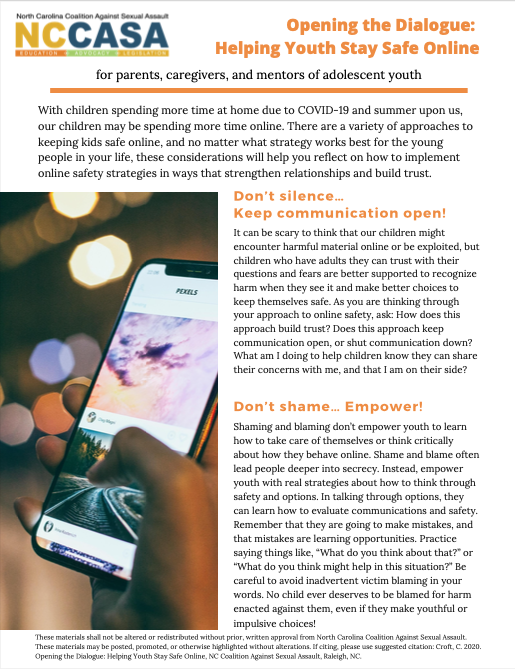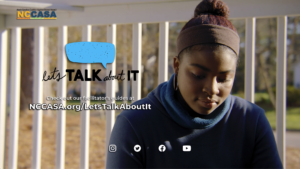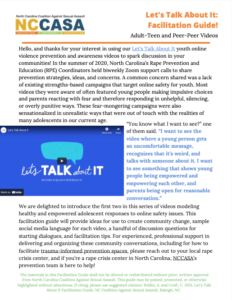In spring of 2020, I was facilitating bimonthly meetings with all of my state’s CDC-funded Rape Prevention and Education preventionists. During one of our meetings, some of our preventionists mentioned a recent campaign they’d seen on social media in which an anti-trafficking nonprofit was posting “social media safety” tips for parents of adolescents that were predominantly rooted in fear, control, punishment, and sensationalism. As they discussed it, it became clear that all of the preventionists disagreed with this strategy and wished that there was alternative messaging to support open communication and empowering youth with information to notice red flags an care for themselves in online settings. For our next three meetings, I facilitated discussion among the preventionists about what their ideal messaging would say, and from those notes I created Opening the Dialogue: Helping Youth Stay Safe Online (available in English and Spanish on NCCASA’s website).
During those conversations, one theme came up repeatedly — we have dozens of videos showing both children and parents doing what we don’t want them to do. Adolescents are shown as naive and incapable of making good choices, and adults are shown as controlling and punitive. Our preventionists said: “Where’s the video of people doing things we want them to do? Where is the video of youth noticing when something feels off, supporting each other, or asking adults when something feels off? Where’s the video of parents hearing about an online safety issue, calming their fears, and having a clear and open communication with their young person? That’s the video I want to see!”
Later that year, I was able to develop the script for exactly those alternative videos, and get them produced! One shows a young person noticing that something feels off and reaching out to a friend, who validates their feelings and affirms that it’s okay to set whatever boundaries are needed. Another shows a young person receiving a message that feels off and discussing with a trusted adult, who takes a moment to get herself together before replying for an open conversation.
Our preventionists were DELIGHTED to see their ideas come to life. In order to make it easier for them to use these videos, I supervised and co-authored a facilitation guide for folks hoping to use these videos in an educational setting. The guide includes sample social media captions for each video, facilitation tips for those who aren’t as familiar with facilitating complex conversations, and three sets of sample discussion questions: Some for use in youth settings, some for use with parents/adult settings, and some for intergenerational settings to get youth and adults engaged in shared dialogue about what makes it hard to talk openly about online safety.
These videos and their accompanying facilitation guides are available in both English and Spanish at NCCASA’s website.
Project manager, script developer, co-author



